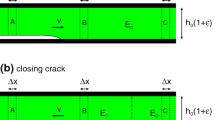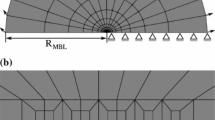Abstract.
We present a simple theory of crack propagation in viscoelastic solids. We calculate the energy per unit area, G(v), to propagate a crack, as a function of the crack tip velocity v. Our study includes the non-uniform temperature distribution (flash temperature) in the vicinity of the crack tip, which has a profound influence on G(v). At very low crack tip velocities, the heat produced at the crack tip can diffuse away, resulting in very small temperature increase: in this “low-speed” regime the flash temperature effect is unimportant. However, because of the low heat conductivity of rubber-like materials, already at moderate crack tip velocities a very large temperature increase (of order of 1000 K) can occur close to the crack tip. We show that this will drastically affect the viscoelastic energy dissipation close to the crack tip, resulting in a “hot-crack” propagation regime. The transition between the low-speed regime and the hot-crack regime is very abrupt, which may result in unstable crack motion, e.g. stick-slip motion or catastrophic failure, as observed in some experiments. In addition, the high crack tip temperature may result in significant thermal decomposition within the heated region, resulting in a liquid-like region in the vicinity of the crack tip. This may explain the change in surface morphology (from rough to smooth surfaces) which is observed as the crack tip velocity is increased above the instability threshold.
Similar content being viewed by others
References
G. Heinrich, J. Stuve, G. Gerber, Polymer 43, 395 (2002).
C. Creton, H. Lakrout, J. Polym. Sci. B, Polym. Phys. 38, 965 (2000).
G. Carbone, L. Mangialardi, J. Mech. Phys. Solids 52, 1267 (2004).
A.N. Gent, J. Schultz, J. Adhes. 3, 281 (1972).
D. Maugis, M. Barquins, J. Phys. D 11, 1989 (1978).
A.N. Gent, Langmuir 12, 4492 (1996).
M.L. Williams, R.F. Landel, J.D. Ferry, J. Am. Chem. Soc. 77, 3701 (1955).
B.N.J. Persson, J. Chem. Phys. 115, 3840 (2001).
P.G. de Gennes, Langmuir 12, 4497 (1996).
R.A. Schapery, Int. J. Fract. 11, 141
J.A. Greenwood, K.L. Johnson, Philos. Mag. A 43, 697 (1981).
M. Barber, J. Donley, J.S. Langer, Phys. Rev. A 40, 366 (1989).
J.M. Baney, C.Y. Hui, J. Appl. Phys. 86, 4232 (1999)
B.N.J. Persson, E.A. Brener, Phys. Rev. E 71, 036123 (2005).
G.I. Barenblatt, Adv. Appl. Mech. 7, 55 (1962).
E.E. Gdoutos, P.M. Schubel, I.M. Daniel, Strain 40, 119 (2004).
J.T. South, S.W. Case, K.L. Reifsnider, Mech. Mater. 34, 451 (2002).
K. Tsunoda, J.J.C. Busfield, C.K.L. Davies, A.G. Thomas, J. Mater. Sci. 35, 5187 (2000).
B.N.J. Persson, in preparation.
A.A. Griffith, Philos. Trans. R. Soc. London, A 221, 163 (1920).
T.L. Anderson, Fracture Mechanics: Fundamentals and Applications (CRC Press, Boca Raton, 1995).
R.M. Christensen, Int. J. Fract. 15, 3 (1979).
R.M. Christensen Theory of Viscoelasticity, 2nd edition (Dover Publications, Inc., Mineola, New York, 2003).
A.G. Thomas, J. Polym. Sci. 18, 177 (1955).
A similar approach has already been applied successfully to rubber friction on rough substrates, where the flash temperature has a profound influence on the friction dynamics (B.N.J. Persson, unpublished).
K.L. Johnson, in V.V. Tsukruk, K.J. Wahl (Editors), Microstructure and Microtribology of Polymer Surfaces (American Chemical Society, Washington, DC, 2000) pp. 24-41.
K.N.G. Fuller, P.G. Fox, J.E. Field, Proc. R. Soc. London, Ser. A 341, 537 (1975).
P.G. Fox, Soria-Ruiz, Proc. R. Soc. London, Ser. A 317, 79 (1970).
R.D. Deegan, P.J. Petersan, M. Marder, H.L. Swinney, Phys. Rev. Lett. 88, 014304 (2002)
L.B. Freund, Dynamical Fracture Mechanics (Cambridge University Press, Cambridge, 1990).
M. Marder, Phys. Rev. Lett. 94, 048001 (2005).
B.N.J. Persson, Phys. Rev. Lett. 81, 3439 (1998)
D.S. Dugdale, J. Mech. Phys. Solids 8, 100 (1960).
A.D. Roberts, A.G. Thomson, Wear 33, 45 (1975).
F. Lacroix, A. Tougui, N.R. Neelakantan, N. Ranganathan, A new approach for crack growth life of an elastomeric material, in The 15th European Conference of Fracture-Advanced Fracture Mechanics for Life and Safety Assessments, Stockholm, Sweden, August 11-13, 2004.
Author information
Authors and Affiliations
Corresponding author
Rights and permissions
About this article
Cite this article
Carbone, G., Persson, B.N.J. Crack motion in viscoelastic solids: The role of the flash temperature. Eur. Phys. J. E 17, 261–281 (2005). https://doi.org/10.1140/epje/i2005-10013-y
Received:
Accepted:
Published:
Issue Date:
DOI: https://doi.org/10.1140/epje/i2005-10013-y




